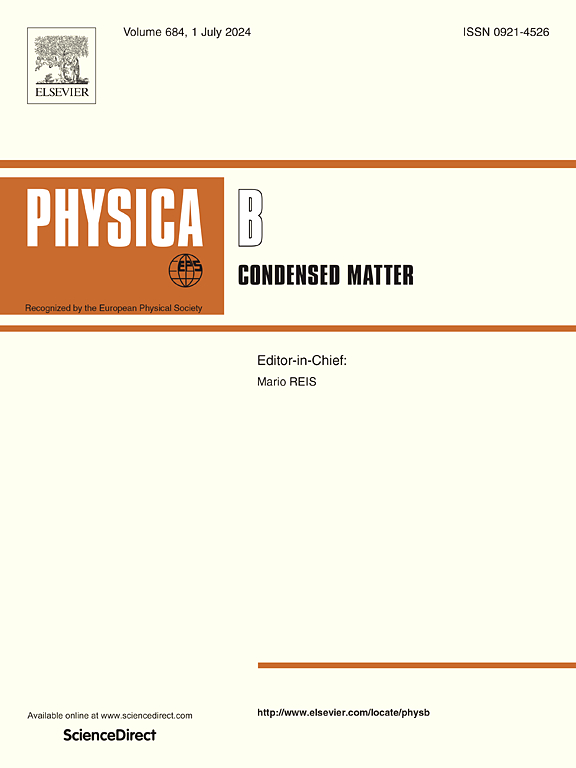用于绿色能量收集的γ- nabea半heusler材料的光学和输运性质
IF 2.8
3区 物理与天体物理
Q2 PHYSICS, CONDENSED MATTER
引用次数: 0
摘要
本研究利用基于密度泛函理论的第一性原理计算,结合半经典玻尔兹曼输运理论,研究了nabea的结构、动力学、力学、热力学、电子、光学和输运性质。结果表明,nabea在γ相中结构、动力学、力学和热力学稳定,而在α和β相中不稳定。通过声子谱评估、弹性常数标准和地层能量计算来评估其稳定性(ΔHf)。电子特性显示了1.51 eV的直接带隙,证实了材料的半导体性质。nabea具有独特的光学特性,如高折射率、优异的外量子效率(ηOpt= 58.84%)、低可见光反射率(R(ω) <;50%),强紫外吸收(αmax(ω)≈1.75×106cm−1)。还分析了温度和载流子浓度相关的热电性质。发现了一种新型n型NaBeAs合金,在300 K时具有接近单位的高品质系数zT (zT ~ 1),在700 K温度梯度下的热电功率转换效率为ηTE = 16.58%。该结果为该合金的后续实验研究提供了理论基础,强调了其在绿色能源收集应用方面的潜力。本文章由计算机程序翻译,如有差异,请以英文原文为准。

Optical and transport proprieties of γ-NaBeAs half-Heusler material for green energy harvesting applications
This study investigates the structural, dynamic, mechanical, thermodynamic, electronic, optical and transport properties of NaBeAs using first principles calculations based on density functional theory, coupled with the semi-classical Boltzmann transport theory. The results reveal that NaBeAs is stable structurally, dynamically, mechanically and thermodynamically in the phase but unstable in other phases and . The stabilities were assessed using phonon spectrum evaluations, compliance with elastic constant criteria, and calculations of the formation energy (). The electronic properties show a direct band gap of 1.51 eV, confirming the material’s semiconducting nature. NaBeAs exhibits unique optical features, such as a high refractive index, excellent external quantum efficiency (= 58.84 %), low reflectivity in the visible spectrum ( R() 50%), and strong ultraviolet absorption ( cm). Temperature- and carrier concentration-dependent thermoelectric properties were also analyzed. A new n-type NaBeAs alloy has been discovered, showing a high figure of merit (zT) close to unity (zT 1) at 300 K and a thermoelectric power conversion efficiency of = 16.58 % with a 700 K temperature gradient. The results present a theoretical basis for upcoming experimental studies of this alloy, emphasizing its potential for green energy harvesting applications.
求助全文
通过发布文献求助,成功后即可免费获取论文全文。
去求助
来源期刊

Physica B-condensed Matter
物理-物理:凝聚态物理
CiteScore
4.90
自引率
7.10%
发文量
703
审稿时长
44 days
期刊介绍:
Physica B: Condensed Matter comprises all condensed matter and material physics that involve theoretical, computational and experimental work.
Papers should contain further developments and a proper discussion on the physics of experimental or theoretical results in one of the following areas:
-Magnetism
-Materials physics
-Nanostructures and nanomaterials
-Optics and optical materials
-Quantum materials
-Semiconductors
-Strongly correlated systems
-Superconductivity
-Surfaces and interfaces
 求助内容:
求助内容: 应助结果提醒方式:
应助结果提醒方式:


